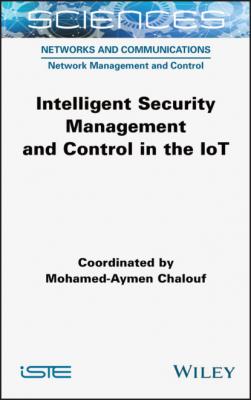ТОП просматриваемых книг сайта:
Intelligent Security Management and Control in the IoT. Mohamed-Aymen Chalouf
Читать онлайн.Название Intelligent Security Management and Control in the IoT
Год выпуска 0
isbn 9781394156023
Автор произведения Mohamed-Aymen Chalouf
Жанр Зарубежная компьютерная литература
Издательство John Wiley & Sons Limited
13 10 Adapting the Security Level of IoT Applications 10.1. Introduction 10.2. Definitions and characteristics 10.3. IoT applications 10.4. IoT architectures 10.5. Security, trust and privacy protection in IoT applications 10.6. Adapting the security level in the IoT 10.7. Conclusion 10.8. References
14 11 Moving Target Defense Techniques for the IoT 11.1. Introduction 11.2. Background 11.3. Related works 11.4. LMTD for the IoT: a qualitative survey 11.5. Network components in the IoT: a vast domain for MTD 11.6. An MTD framework for the IoT 11.7. Discussion and avenues for future research 11.8. Conclusion 11.9. References
16 Index
List of Tables
1 Chapter 1Table 1.1. Some vehicular network services and the corresponding QoS parametersTable 1.2. Weight estimation for services considered in vehicular networksTable 1.3. Simulation parameters for scenario 1Table 1.4. Simulation parameters for scenario 2Table 1.5. Simulation parameters for the SUMO vehicle
2 Chapter 2Table 2.1. Physical channel and signals from the NB-IoT
3 Chapter 3Table 3.1. Summary of articles presented
4 Chapter 4Table 4.1. Parameters for simulation scenariosTable 4.2. Characteristics of simulation scenarios 1 and 2Table 4.3. Characteristics of simulation scenarios 3 and 4
5 Chapter 5Table 5.1. Model Open Systems Interconnection (OSI) in “classic” Internet protoc...
6 Chapter 6Table 6.1. Characteristics of different sources of energy (from Vullers et al. 2...Table 6.2. Set of rules used by the inference motorTable 6.3. Simulation parameter values. Details of parameters of P-FREEN, Fuzzym...
7 Chapter 7Table 7.1. IoT-MAAC attributesTable 7.2. Principle of the inference base of the TSK model for evaluating the t...
8 Chapter 8Table 8.1. Comparison of biometric characteristics according to the following pr...Table 8.2. Description of authentication factorsTable 8.3. Notation table
9 Chapter 11Table 11.1. Tokens in the MTD domainTable 11.2. Physical layer components (OSI L1) and variants for the IoTTable 11.3. Components of the link layer (OSI L2) and its variants for the IoTTable 11.4. Components of the network layer (OSI L3) and its variants for the Io...Table 11.5. Components of the transport layer (OSI L4) and its variants for the ...Table 11.6. Application (OSI L5-7) layer components and variants for the IoT
List of Illustrations
1 Chapter 1Figure 1.1. Proposed architecture for a context aware IoT device/object. For a c...Figure 1.2. General context of decision-makingFigure 1.3. Transmission of video from the scene of an accident in VANET network...Figure 1.4. Score variation in VANET networks for transmission of a video messag...Figure 1.5. Entertainment service on a highway in CR-VANET networksFigure 1.6. Variation of the scores of intelligent radio channels for the entert...
2 Chapter 2Figure 2.1. Impact on performance of the number of IoT devices simultaneously at...Figure 2.2. NB-IoT deployment modesFigure 2.3. Structure of a preamble sequence. For a color version of this figure...Figure 2.4. Random access procedureFigure 2.5. System model. For a color version of this figure, see www.iste.co.uk...Figure 2.6. System for regulating arrivalsFigure 2.7. Access probability with the adaptive controllerFigure 2.8 Access probability with the controller using TD3Figure 2.9. Average latency of the terminals with the adaptive controllerFigure 2.10. Average latency of the terminals with the controller using TD3Figure 2.11. The average recompense with the adaptive controllerFigure 2.12. The average recompense with the controller using TD3Figure 2.13. Access attempts (blue) and abandonments (red) with the adaptive con...Figure 2.14. Access attempts (blue) and abandonments (red) with the controller u...
3 Chapter 3Figure 3.1. The four visions of the IoT (Akinyoade and Eluwole 2019)Figure 3.2. Cloud, Fog and Edge. For a color version of this figure, see www.ist...Figure 3.3. Features for spectrum management in intelligent radio. For a color v...Figure 3.4. Integration of multiple technologies in the IoT. For a color version...
4 Chapter 4Figure 4.1. Architecture of the Internet of Things (Khalil et al. 2018). For a c...Figure 4.2. MAPE-K Control loopFigure 4.3. MAPE-K loop from the IoT energy self-optimization framework. For a c...Figure 4.4. Membership functions of the “distance” parameter. For a color versio...Figure 4.5. Membership functions of the “residual energy” parameter. For a color...Figure 4.6. Membership functions of the “precision” parameter. For a color versi...Figure 4.7. Membership functions of the output parameter. For a color version of...Figure 4.8. Decision-making algorithmFigure 4.9. Lifespan of the IoT system for scenarios 1 and 2Figure 4.10. Lifespan of the IoT system for scenario 3Figure 4.11. Average precision of the information recorded in scenario 4. For a ...Figure 4.12. Selection of IoT objects over time in scenario 4. For a color versi...
5 Chapter 5Figure 5.1. Example of star topology and mesh topology in an IoT network. For a ...Figure 5.2. Example of a size 6 slotframe, for a 4-node network and a coordinato...Figure 5.3. Example of TSCH schedule and topology showing Replication, Overheari...
6 Chapter 6Figure 6.1. Architecture of an energy-harvesting sensor node. For a color versio...Figure 6.2. Energy buffer thresholds. For a color version of this figure, see ww...Figure 6.3. Periodic execution of the EM. For a color version of this figure, se...Figure 6.4. Architecture of energy managers with and without prediction. For a c...Figure 6.5. Fuzzyman architectureFigure 6.6. Membership functions used by the fuzzing unitFigure 6.7. Performance of Fuzzyman and P-FREEN depending on PAVG for different ...Figure 6.8. Global RLMan architecture. For a color

